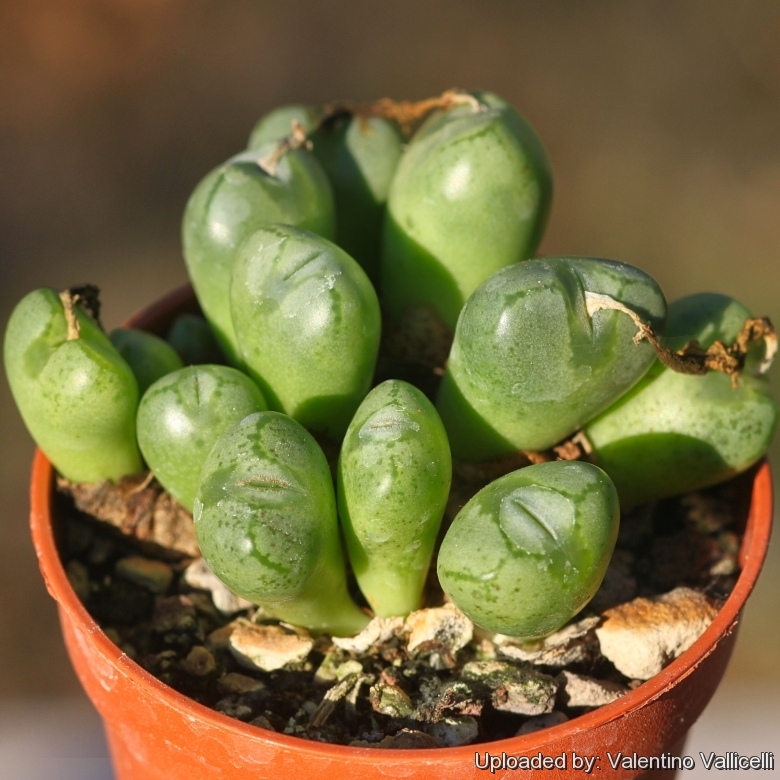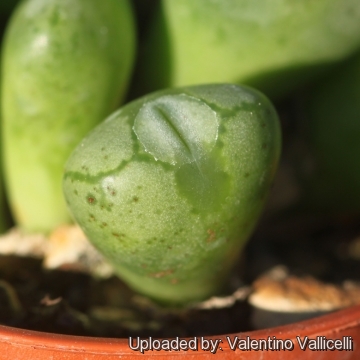
Conophytum violaciflorum Photo by: Valentino Vallicelli
Origin and Habitat: Little Namaqualand, near Springbok Fontein, and even occurs within the town limits. Northern Cape, South Africa
Altitude: 900-1320 metres above sea level.
Habitat: Conophytum violaciflorumSN|26013]]SN|26013]] occurs on quartz hills. Although the plant is endemic to a small distribution area, it currently has a stable population in nature and is not considered threatened.
Synonyms:
See all synonyms of Conophytum violaciflorum
back
Accepted name in llifle Database:Conophytum violaciflorum Schick & TischerMöller's deutsche gärtner-zeitung 43: 238 1928Synonymy: 3
back
Common Names include:
RUSSIAN (Русский): Конофитум фиолетовоцветковый
Description: Conophytum violaciflorumSN|18625]]SN|26013]] is a dwarf succulent that grows a dense clump. This was named for its purplish-violet flowers. In all forms it is an easy and floriferous species that is allied to the Conophytum tantillumSN|26013]]SN|18625]] complex.
Bodies (two-lobed leaves): Oblong to cylindrical in basal shape, wedged, and erectly positioned, shiny pale green or grey-green often with scattered tiny dark green spots. The lobes may have dark-green or maroon rims on their angular margins. Relics of old leaves are often stuck in the grooves among the succulent leaf bodies.
Flowers: Violet to purplish, freely-produced.
Bibliography: Major references and further lectures
1) Gordon D. Rowley “The illustrated encyclopedia of succulents” Crown Publishers, 01/Aug/1978
2) James Cullen, Sabina G. Knees, H. Suzanne Cubey “The European Garden Flora Flowering Plants: A Manual for the Identification of Plants Cultivated in Europe, Both Out-of-Doors” Cambridge University Press, 11/Aug./2011
3) Matlamela, P.F. & Kamundi, D.A. 2006. Conophytum violaciflorum Schick & Tischer. National Assessment: "Red List of South African Plants" version 2013.1. Accessed on 2014/01/26
4) Hammer, S. 1993. “The Genus Conophytum - A Conograph.” Succulent Plant Publications, Pretoria.
5) Hammer, S. 2002. “Dumpling and His Wife: New Views of the Genus Conophytum.” East Anglia Engraving Creative Colour Ltd, Norwich, England.
6) Ernst Van Jaarsveld, Ben-Erik Van Wyk, Gideon Smith “Succulents of South Africa: A Guide to the Regional Diversity” Tafelberg Publishers, Limited, 01/lug/2000
7) Heidrun E.K. Hartmann “Illustrated Handbook of Succulent Plants: Aizoaceae A-E” Springer, 2002
8) Werner Rauh “The Wonderful World of Succulents: Cultivation and Description of Selected Succulent Plants Other Than Cacti” Smithsonian Institution Press, 1984
9) Hermann Jacobsen “Lexicon of Succulent Plants” Littlehampton Book Services Ltd. 1974
 Conophytum violaciflorum Photo by: Valentino Vallicelli
Conophytum violaciflorum Photo by: Valentino VallicelliSend a photo of this plant.The gallery now contains thousands of pictures, however it is possible to do even more. We are, of course, seeking photos of species not yet shown in the gallery but not only that, we are also looking for better pictures than those already present.
Read More... Cultivation and Propagation: Conophytum violaciflorumSN|26013]]SN|26013]] is a "winter" grower which is most active from late winter until later spring and heading for summer dormancy.
Soil: Best in pots. Requires good drainage as it it is prone to root rot. It can grows outdoor in sunny, dry, rock crevices (protection against winter wet is required) It can also be cultivated in alpine house, in poor, drained soil.
Watering: It requires little water; otherwise its epidermis breaks (resulting in unsightly scars). Water minimally in summer, (only when the plant starts shrivelling), but it will generally grow even in summer if given water. Water regularly in winter after the previous year's leaves have dried up. Requires good drainage.
Fertilization: Feed it once during the growing season with a fertilizer specifically formulated for cactus succulents (poor in nitrogen), including all micro nutrients and trace elements diluted to ½ the strength recommended on the label. It thrives in poor soils and need a limited supplies of fertilizer to avoid the plants developing excess vegetation, which is easily attacked by fungal diseases.
Exposure: Keep cool and shaded in summer, it needs full sun or light shade.
Temperature: Hardy to -2°C. Ensure a very good ventilation.
Repotting: Avoid to repot frequently. This plant may stay in the same pot for many years.
Uses: Container, rock garden.
Pests and diseases: It is vulnerable to mealybugs and rarely scale.
Propagation: It can be reproduced both by cuttings and seeds. Take the cutting from a grown-up mother plant. Each cutting must contain one or more heads along with a fraction of root. It is easily propagated by seed. The small seeds can be sown in pots of fine, well-drained sand, any time during the spring and summer months when temperatures are warm. Cover the seeds with a very fine layer of grit and water from below with a fungicide to prevent damping off. For the first 3-4 days cover the pots with a sheet of glass/clear perspex to keep the humidity levels high. Remove the glass and replace it with light shadecloth and mist once or twice a day for the next two weeks after which most seeds should have germinated. From then on mistings can be reduced to every second and then every third day as the little plants grow.












